The Effect of Pretreatment on a PtCu/C Catalyst’s Structure and Functional Characteristics
Abstract
:1. Introduction
2. Results
3. Materials and Methods
3.1. Synthesis and Pretreatment
3.2. Characterization
3.3. Electrocatalytic Test
4. Conclusions
Supplementary Materials
Author Contributions
Funding
Institutional Review Board Statement
Informed Consent Statement
Data Availability Statement
Acknowledgments
Conflicts of Interest
References
- Sun, H.; Xu, X.; Kim, H.; Jung, W.; Zhou, W.; Shao, Z. Electrochemical Water Splitting: Bridging the Gaps between Fundamental Research and Industrial Applications. Energy Environ. Mater. 2022, e12441. [Google Scholar] [CrossRef]
- Zhang, X.; Li, H.; Yang, J.; Lei, Y.; Wang, C.; Wang, J.; Tang, Y.; Mao, Z. Recent Advances in Pt-Based Electrocatalysts for PEMFCs. RSC Adv. 2021, 11, 13316–13328. [Google Scholar] [CrossRef] [PubMed]
- Mølmen, L.; Eiler, K.; Fast, L.; Leisner, P.; Pellicer, E. Recent Advances in Catalyst Materials for Proton Exchange Membrane Fuel Cells. APL Mater. 2021, 9, 040702. [Google Scholar] [CrossRef]
- Zaman, S.; Huang, L.; Douka, A.I.; Yang, H.; You, B.; Xia, B.Y. Oxygen Reduction Electrocatalysts toward Practical Fuel Cells: Progress and Perspectives. Angew. Chem. Int. Ed. 2021, 60, 17832–17852. [Google Scholar] [CrossRef] [PubMed]
- Wang, X.X.; Swihart, M.T.; Wu, G. Achievements, Challenges and Perspectives on Cathode Catalysts in Proton Exchange Membrane Fuel Cells for Transportation. Nat. Catal. 2019, 2, 578–589. [Google Scholar] [CrossRef]
- Xiao, F.; Wang, Y.; Wu, Z.; Chen, G.; Yang, F.; Zhu, S.; Siddharth, K.; Kong, Z.; Lu, A.; Li, J.; et al. Recent Advances in Electrocatalysts for Proton Exchange Membrane Fuel Cells and Alkaline Membrane Fuel Cells. Adv. Mater. 2021, 33, 2006292. [Google Scholar] [CrossRef]
- Wu, D.; Shen, X.; Pan, Y.; Yao, L.; Peng, Z. Platinum Alloy Catalysts for Oxygen Reduction Reaction: Advances, Challenges and Perspectives. ChemNanoMat 2020, 6, 32–41. [Google Scholar] [CrossRef] [Green Version]
- Chen, J.; Ou, Z.; Chen, H.; Song, S.; Wang, K.; Wang, Y. Recent Developments of Nanocarbon Based Supports for PEMFCs Electrocatalysts. Chin. J. Catal. 2021, 42, 1297–1326. [Google Scholar] [CrossRef]
- Liu, Z.; Ma, L.; Zhang, J.; Hongsirikarn, K.; Goodwin, J.G. Pt Alloy Electrocatalysts for Proton Exchange Membrane Fuel Cells: A Review. Catal. Rev. 2013, 55, 255–288. [Google Scholar] [CrossRef]
- Jiang, R.; Tung, S.o.; Tang, Z.; Li, L.; Ding, L.; Xi, X.; Liu, Y.; Zhang, L.; Zhang, J. A Review of Core-Shell Nanostructured Electrocatalysts for Oxygen Reduction Reaction. Energy Storage Mater. 2018, 12, 260–276. [Google Scholar] [CrossRef]
- Belenov, S.; Alekseenko, A.; Pavlets, A.; Nevelskaya, A.; Danilenko, M. Architecture Evolution of Different Nanoparticles Types: Relationship between the Structure and Functional Properties of Catalysts for PEMFC. Catalysts 2022, 12, 638. [Google Scholar] [CrossRef]
- Rahman, M. Positive Impact of Acid-Heat Treatment on the Electrocatalytic Performance of Highly Active and Low Pt-Based Nanostructured Alloy Catalysts for Oxygen Reduction Reactions to Electrochemical Energy Conversion Devices. Energy Technol. 2022, 2201026. [Google Scholar] [CrossRef]
- Gan, L.; Heggen, M.; O’Malley, R.; Theobald, B.; Strasser, P. Understanding and Controlling Nanoporosity Formation for Improving the Stability of Bimetallic Fuel Cell Catalysts. Nano Lett. 2013, 13, 1131–1138. [Google Scholar] [CrossRef] [PubMed]
- Jung, J.Y.; Kim, D.; Jang, I.; Kim, N.D.; Yoo, S.J.; Kim, P. Synthesis of Hollow Structured PtNi/Pt Core/Shell and Pt-Only Nanoparticles via Galvanic Displacement and Selective Etching for Efficient Oxygen Reduction Reaction. J. Ind. Eng. Chem. 2022, 111, 300–307. [Google Scholar] [CrossRef]
- Gan, L.; Heggen, M.; Rudi, S.; Strasser, P. Core–Shell Compositional Fine Structures of Dealloyed Pt x Ni 1– x Nanoparticles and Their Impact on Oxygen Reduction Catalysis. Nano Lett. 2012, 12, 5423–5430. [Google Scholar] [CrossRef]
- Lopez-Haro, M.; Dubau, L.; Guétaz, L.; Bayle-Guillemaud, P.; Chatenet, M.; André, J.; Caqué, N.; Rossinot, E.; Maillard, F. Atomic-Scale Structure and Composition of Pt3Co/C Nanocrystallites during Real PEMFC Operation: A STEM–EELS Study. Appl. Catal. B 2014, 152–153, 300–308. [Google Scholar] [CrossRef]
- Luo, M.; Wei, L.; Wang, F.; Han, K.; Zhu, H. Gram-Level Synthesis of Core–Shell Structured Catalysts for the Oxygen Reduction Reaction in Proton Exchange Membrane Fuel Cells. J. Power Sources 2014, 270, 34–41. [Google Scholar] [CrossRef]
- Menshchikov, V.; Alekseenko, A.; Guterman, V.; Nechitailov, A.; Glebova, N.; Tomasov, A.; Spiridonova, O.; Belenov, S.; Zelenina, N.; Safronenko, O. Effective Platinum-Copper Catalysts for Methanol Oxidation and Oxygen Reduction in Proton-Exchange Membrane Fuel Cell. Nanomaterials 2020, 10, 742. [Google Scholar] [CrossRef] [Green Version]
- Kirakosyan, S.A.; Alekseenko, A.A.; Guterman, V.E.; Novomlinskii, I.N.; Men’shchikov, V.S.; Gerasimova, E.V.; Nikulin, A.Y. De-Alloyed PtCu/C Catalysts of Oxygen Electroreduction. Russ. J. Electrochem. 2019, 55, 1258–1268. [Google Scholar] [CrossRef]
- Gatalo, M.; Moriau, L.; Petek, U.; Ruiz-Zepeda, F.; Šala, M.; Grom, M.; Galun, T.; Jovanovič, P.; Pavlišič, A.; Bele, M.; et al. CO-Assisted Ex-Situ Chemical Activation of Pt-Cu/C Oxygen Reduction Reaction Electrocatalyst. Electrochim. Acta 2019, 306, 377–386. [Google Scholar] [CrossRef]
- Wang, Z.; Yao, X.; Kang, Y.; Miao, L.; Xia, D.; Gan, L. Structurally Ordered Low-Pt Intermetallic Electrocatalysts toward Durably High Oxygen Reduction Reaction Activity. Adv. Funct. Mater. 2019, 29, 1902987. [Google Scholar] [CrossRef]
- Bezerra, C.W.B.; Zhang, L.; Liu, H.; Lee, K.; Marques, A.L.B.; Marques, E.P.; Wang, H.; Zhang, J. A Review of Heat-Treatment Effects on Activity and Stability of PEM Fuel Cell Catalysts for Oxygen Reduction Reaction. J. Power Sources 2007, 173, 891–908. [Google Scholar] [CrossRef]
- Wen, Y.-H.; Zhang, L.-H.; Wang, J.-B.; Huang, R. Atomic-Scale Insights into Thermal Stability of Pt3Co Nanoparticles: A Comparison between Disordered Alloy and Ordered Intermetallics. J. Alloy. Compd. 2019, 776, 629–635. [Google Scholar] [CrossRef]
- Wang, D.; Xin, H.L.; Hovden, R.; Wang, H.; Yu, Y.; Muller, D.A.; DiSalvo, F.J.; Abruña, H.D. Structurally Ordered Intermetallic Platinum–Cobalt Core–Shell Nanoparticles with Enhanced Activity and Stability as Oxygen Reduction Electrocatalysts. Nat. Mater. 2013, 12, 81–87. [Google Scholar] [CrossRef] [PubMed]
- Yang, W.; Zou, L.; Huang, Q.; Zou, Z.; Hu, Y.; Yang, H. Lattice Contracted Ordered Intermetallic Core-Shell PtCo@Pt Nanoparticles: Synthesis, Structure and Origin for Enhanced Oxygen Reduction Reaction. J. Electrochem. Soc. 2017, 164, H331–H337. [Google Scholar] [CrossRef]
- Antolini, E. Alloy vs. Intermetallic Compounds: Effect of the Ordering on the Electrocatalytic Activity for Oxygen Reduction and the Stability of Low Temperature Fuel Cell Catalysts. Appl. Catal. B 2017, 217, 201–213. [Google Scholar] [CrossRef]
- Xing, Z.; Li, J.; Wang, S.; Su, C.; Jin, H. Structure Engineering of PtCu3/C Catalyst from Disordered to Ordered Intermetallic Compound with Heat-Treatment for the Methanol Electrooxidation Reaction. Nano Res. 2022, 15, 3866–3871. [Google Scholar] [CrossRef]
- Jung, W.S.; Lee, J. Induced Changes of Pt/C in Activity and Durability through Heat-Treatment for Oxygen Reduction Reaction in Acidic Medium. Int. J. Hydrog. Energy 2017, 42, 22830–22840. [Google Scholar] [CrossRef]
- Wettergren, K.; Schweinberger, F.F.; Deiana, D.; Ridge, C.J.; Crampton, A.S.; Rötzer, M.D.; Hansen, T.W.; Zhdanov, V.P.; Heiz, U.; Langhammer, C. High Sintering Resistance of Size-Selected Platinum Cluster Catalysts by Suppressed Ostwald Ripening. Nano Lett. 2014, 14, 5803–5809. [Google Scholar] [CrossRef]
- Chung, D.Y.; Chung, Y.-H.; Jung, N.; Choi, K.-H.; Sung, Y.-E. Correlation between Platinum Nanoparticle Surface Rearrangement Induced by Heat Treatment and Activity for an Oxygen Reduction Reaction. Phys. Chem. Chem. Phys. 2013, 15, 13658. [Google Scholar] [CrossRef]
- Hodnik, N.; Jeyabharathi, C.; Meier, J.C.; Kostka, A.; Phani, K.L.; Rečnik, A.; Bele, M.; Hočevar, S.; Gaberšček, M.; Mayrhofer, K.J.J. Effect of Ordering of PtCu 3 Nanoparticle Structure on the Activity and Stability for the Oxygen Reduction Reaction. Phys. Chem. Chem. Phys. 2014, 16, 13610–13615. [Google Scholar] [CrossRef] [PubMed] [Green Version]
- Gatalo, M.; Ruiz-Zepeda, F.; Hodnik, N.; Dražić, G.; Bele, M.; Gaberšček, M. Insights into Thermal Annealing of Highly-Active PtCu3/C Oxygen Reduction Reaction Electrocatalyst: An in-Situ Heating Transmission Electron Microscopy Study. Nano Energy 2019, 63, 103892. [Google Scholar] [CrossRef]
- Pryadchenko, V.V.; Belenov, S.V.; Shemet, D.B.; Volochaev, V.A.; Srabionyan, V.V.; Avakyan, L.A.; Tabachkova, N.Y.; Guterman, V.E.; Bugaev, L.A. The Effect of Thermal Treatment on the Atomic Structure of Core–Shell PtCu Nanoparticles in PtCu/C Electrocatalysts. Phys. Solid State 2017, 59, 1666–1673. [Google Scholar] [CrossRef]
- Wu, B.; Du, F.; Wang, H.; Wu, C.; Chu, J.; Wang, X.; Xiong, S. Effects of Annealing Temperature of PtCu/MWCNT Catalysts on Their Electrocatalytic Performance of Electrooxidation of Methanol. Ionics 2022, 28, 369–382. [Google Scholar] [CrossRef]
- Oezaslan, M.; Hasché, F.; Strasser, P. PtCu 3, PtCu and Pt 3 Cu Alloy Nanoparticle Electrocatalysts for Oxygen Reduction Reaction in Alkaline and Acidic Media. J. Electrochem. Soc. 2012, 159, B444–B454. [Google Scholar] [CrossRef]
- Dutta, I.; Carpenter, M.K.; Balogh, M.P.; Ziegelbauer, J.M.; Moylan, T.E.; Atwan, M.H.; Irish, N.P. Electrochemical and Structural Study of a Chemically Dealloyed PtCu Oxygen Reduction Catalyst. J. Phys. Chem. C 2010, 114, 16309–16320. [Google Scholar] [CrossRef] [Green Version]
- Zamanzad Ghavidel, M.R.; Monteverde Videla, A.H.A.; Specchia, S.; Easton, E.B. The Relationship between the Structure and Ethanol Oxidation Activity of Pt-Cu/C Alloy Catalysts. Electrochim. Acta 2017, 230, 58–72. [Google Scholar] [CrossRef]
- Pryadchenko, V.V.; Belenov, S.V.; Shemet, D.B.; Srabionyan, V.V.; Avakyan, L.A.; Volochaev, V.A.; Mikheykin, A.S.; Bdoyan, K.E.; Zizak, I.; Guterman, V.E.; et al. Effect of Thermal Treatment on the Atomic Structure and Electrochemical Characteristics of Bimetallic PtCu Core–Shell Nanoparticles in PtCu/C Electrocatalysts. J. Phys. Chem. C 2018, 122, 17199–17210. [Google Scholar] [CrossRef]
- El-Deeb, H.; Bron, M. Microwave-Assisted Polyol Synthesis of PtCu/Carbon Nanotube Catalysts for Electrocatalytic Oxygen Reduction. J. Power Sources 2015, 275, 893–900. [Google Scholar] [CrossRef]
- Nevelskaya, A.K.; Belenov, S.V.; Guterman, V.E.; Nikulin, A.Y.; Toporkov, N.v. Influence of Heat Treatment on the Microstructure and Functional Characteristics of PtCu/C Catalysts. Nanobiotechnol. Rep. 2022, 17, 83–92. [Google Scholar] [CrossRef]
- Petkov, V.; Maswadeh, Y.; Vargas, J.A.; Shan, S.; Kareem, H.; Wu, Z.-P.; Luo, J.; Zhong, C.-J.; Shastri, S.; Kenesei, P. Deviations from Vegard’s Law and Evolution of the Electrocatalytic Activity and Stability of Pt-Based Nanoalloys inside Fuel Cells by in Operando X-Ray Spectroscopy and Total Scattering. Nanoscale 2019, 11, 5512–5525. [Google Scholar] [CrossRef] [PubMed]
- Guterman, V.E.; Belenov, S.V.; Krikov, V.V.; Vysochina, L.L.; Yohannes, W.; Tabachkova, N.Y.; Balakshina, E.N. Reasons for the Differences in the Kinetics of Thermal Oxidation of the Support in Pt/C Electrocatalysts. J. Phys. Chem. C 2014, 118, 23835–23844. [Google Scholar] [CrossRef]
- Belenov, S.V.; Men’shchikov, V.S.; Nikulin, A.Y.; Novikovskii, N.M. PtCu/C Materials Doped with Different Amounts of Gold as the Catalysts of Oxygen Electroreduction and Methanol Electrooxidation. Russ. J. Electrochem. 2020, 56, 660–668. [Google Scholar] [CrossRef]
- Shen, H.; Li, H.; Yang, Z.; Li, C. Magic of hydrogen spillover: Understanding and application. Green Energy Environ. 2022, 7, 1161–1198. [Google Scholar] [CrossRef]
- Xiong, M.; Gao, Z.; Qin, Y. Spillover in Heterogeneous Catalysis: New Insights and Opportunities. ACS Catal. 2021, 11, 3159–3172. [Google Scholar] [CrossRef]
- Jeon, M.K.; Zhang, Y.; McGinn, P.J. A comparative study of PtCo, PtCr, and PtCoCr catalysts for oxygen electro-reduction reaction. Electrochim. Acta 2010, 55, 5318–5325. [Google Scholar] [CrossRef]
- Ke, K.; Hatanaka, T.; Morimoto, Y. Reconsideration of the quantitative characterization of the reaction intermediate on electrocatalysts by a rotating ring-disk electrode: The intrinsic yield of H2O2 on Pt/C. Electrochim. Acta 2011, 56, 2098–2104. [Google Scholar] [CrossRef]
- Oezaslan, M.; Strasser, P. Activity of dealloyed PtCo3 and PtCu3 nanoparticle electrocatalyst for oxygen reduction reaction in polymer electrolyte membrane fuel cell. J. Power Sources 2011, 196, 5240–5249. [Google Scholar] [CrossRef]
- Pavlets, A.; Alekseenko, A.; Menshchikov, V.; Belenov, S.; Volochaev, V.; Pankov, I.; Safronenko, O.; Guterman, V. Influence of Electrochemical Pretreatment Conditions of PtCu/C Alloy Electrocatalyst on Its Activity. Nanomaterials 2021, 11, 1499. [Google Scholar] [CrossRef] [PubMed]
- Langford, J.I. A Rapid Method for Analysing the Breadths of Diffraction and Spectral Lines Using the Voigt Function. J. Appl. Crystallogr. 1978, 11, 10–14. [Google Scholar] [CrossRef]
- Shinozaki, K.; Zack, J.W.; Pylypenko, S.; Pivovar, B.S.; Kocha, S.S. Oxygen Reduction Reaction Measurements on Platinum Electrocatalysts Utilizing Rotating Disk Electrode Technique. J. Electrochem. Soc. 2015, 162, F1384–F1396. [Google Scholar] [CrossRef]
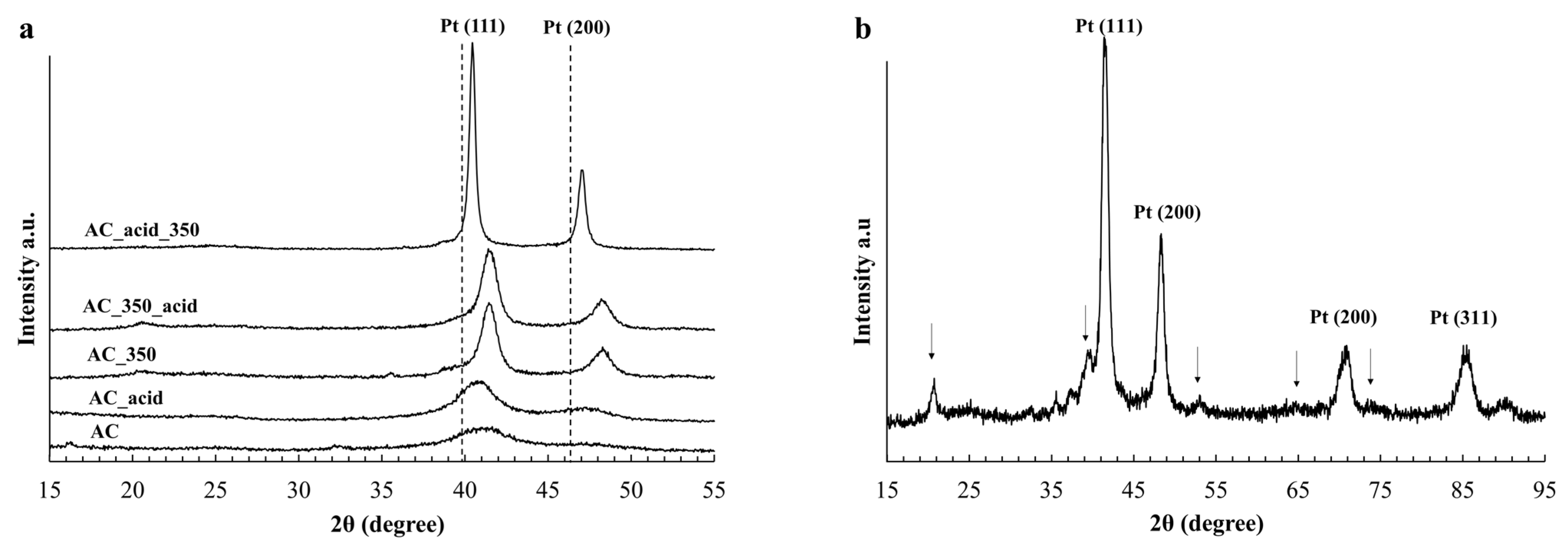
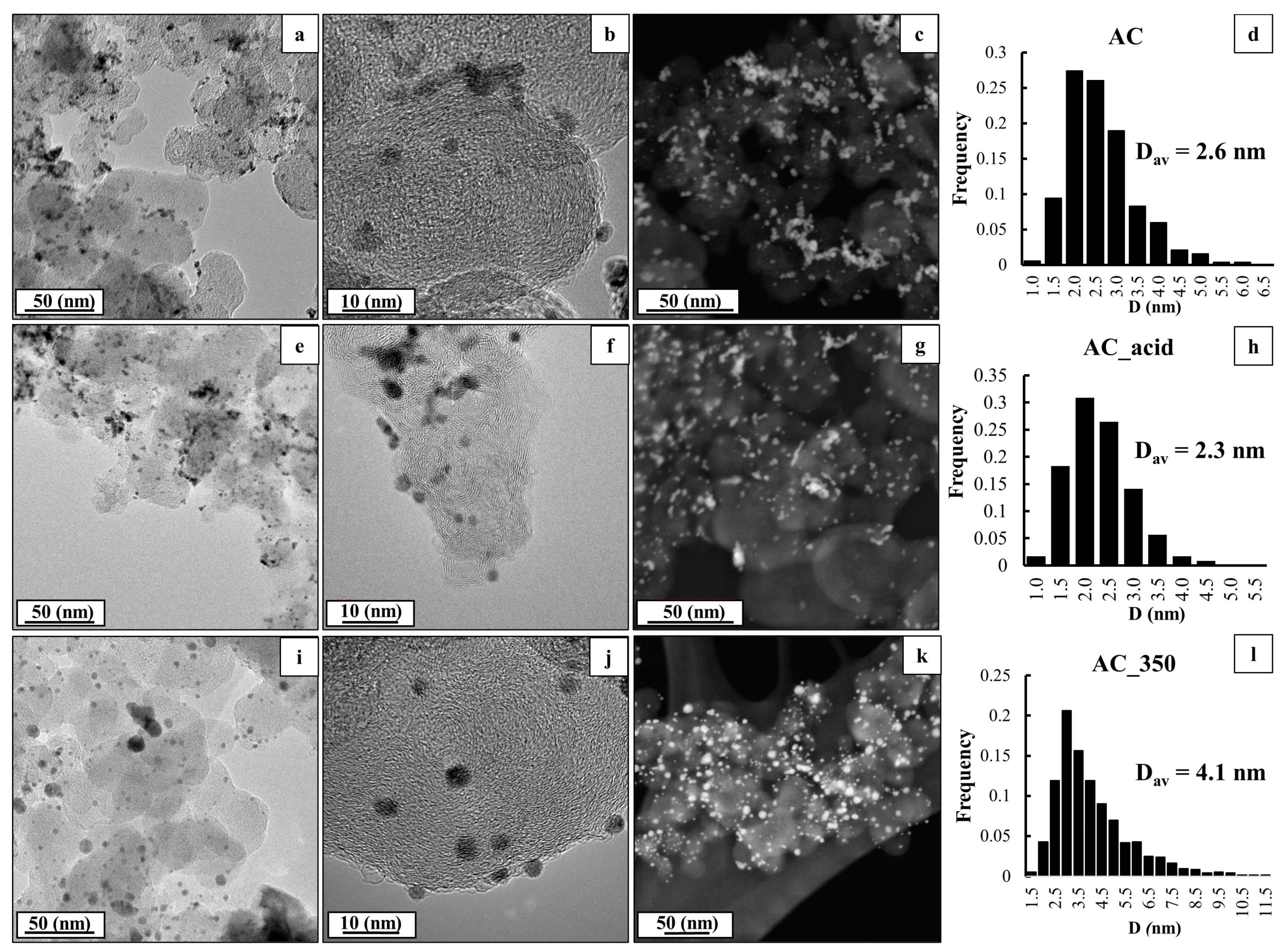

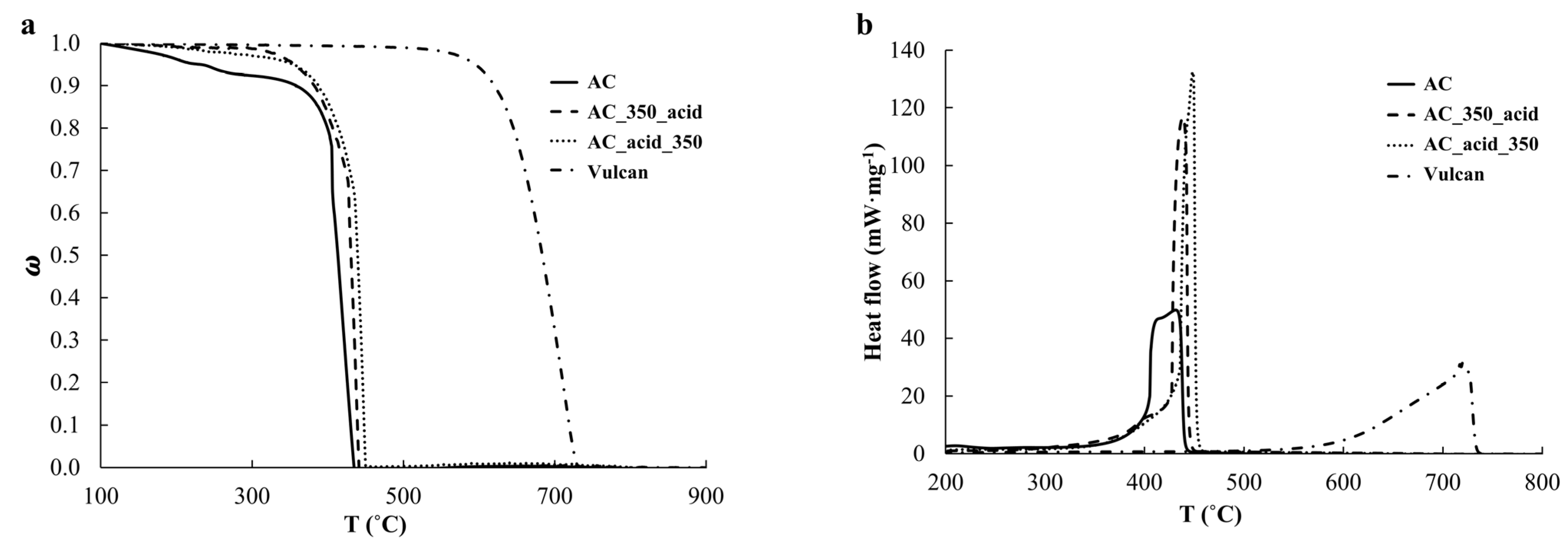
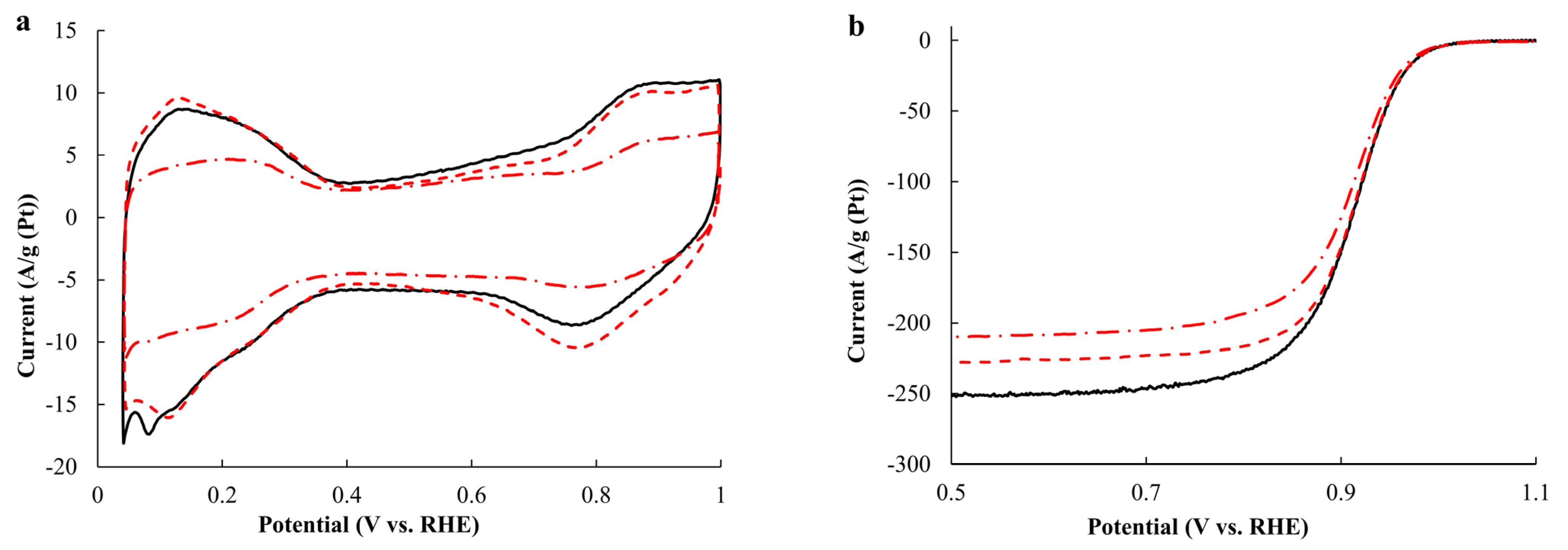
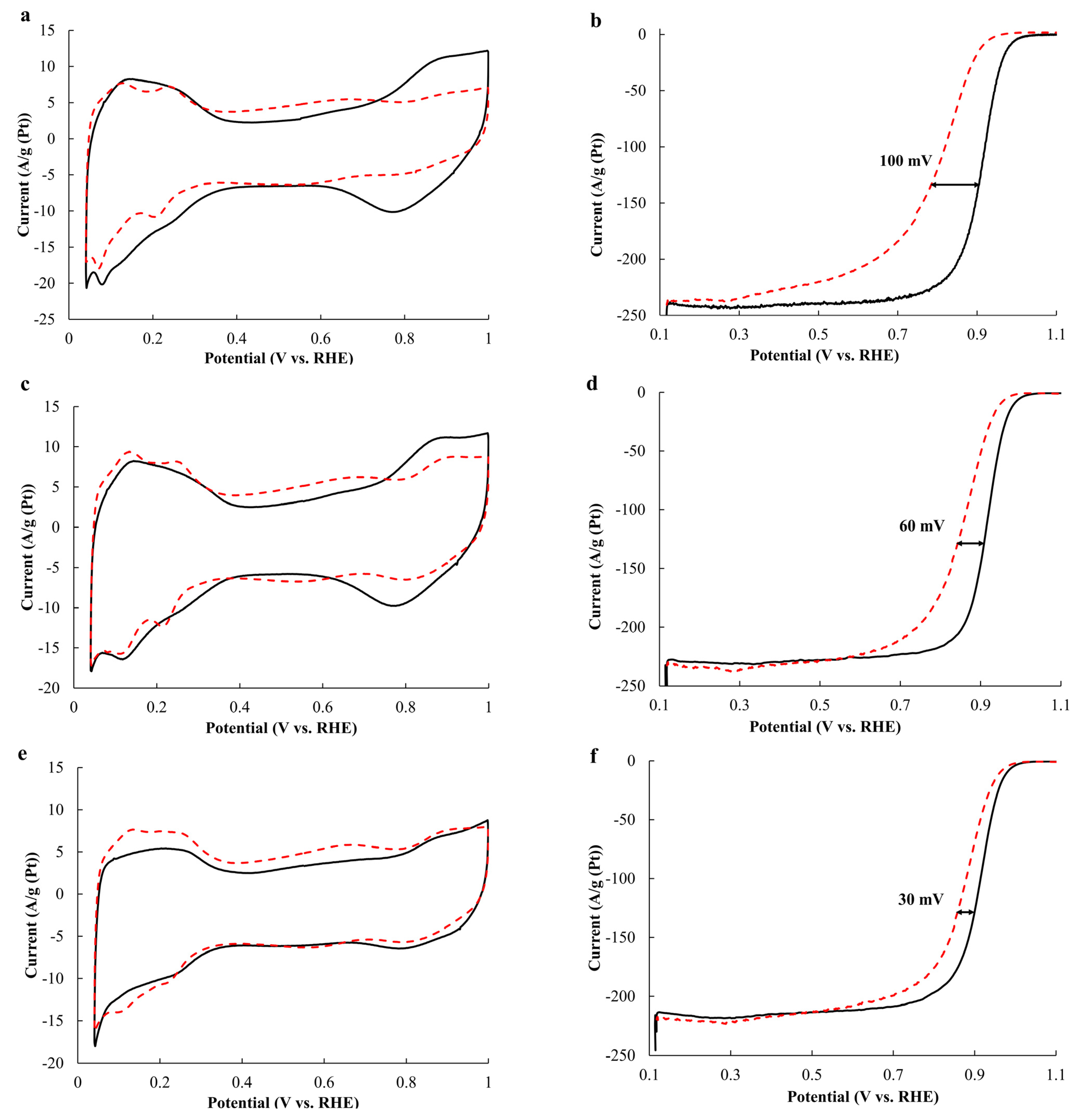
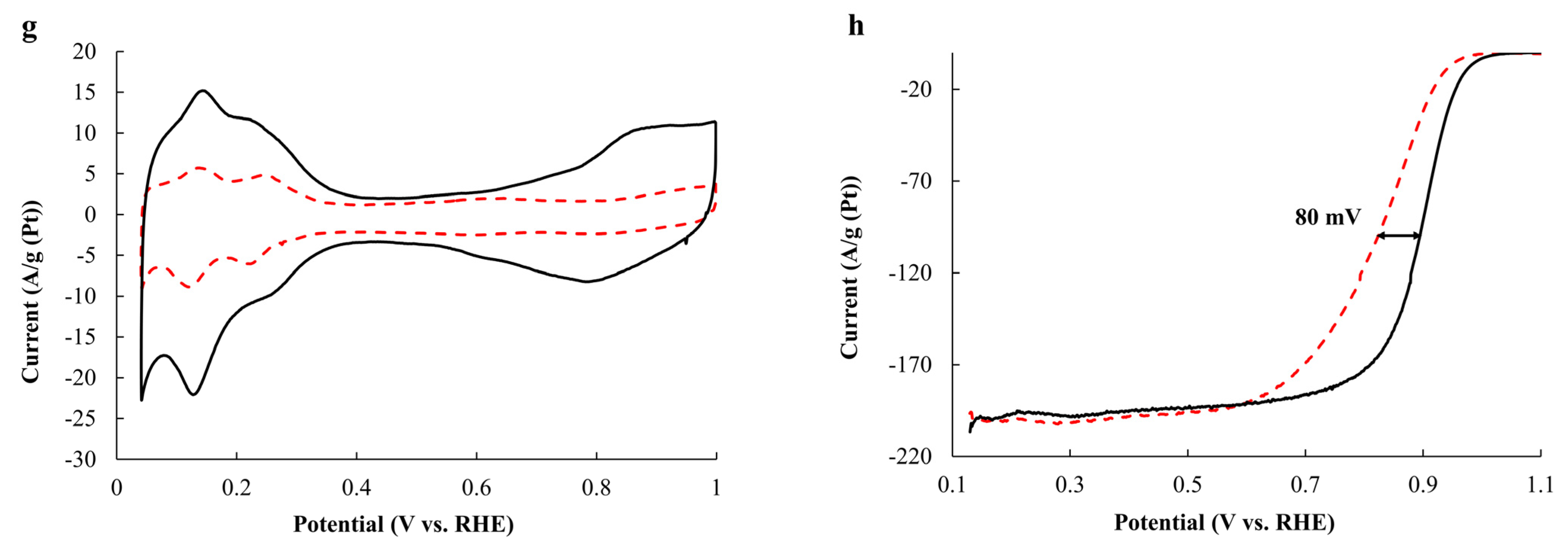


| Sample | 𝝎Pt, % | Composition (Atomic Ratio) | Average Size of NPs, nm | Crystal Lattice Parameter (a), Å | |||
|---|---|---|---|---|---|---|---|
| TXRF | XRD | TXRF after CV | XRD | TEM | |||
| AC | 31 | PtCu1.26 | PtCu0.56 | PtCu0.25 | 2.4 | 2.6 | 3.82(6) |
| AC_acid | 35 | PtCu0.29 | PtCu0.36 | PtCu0.21 | 2.9 | 2.3 | 3.85(2) |
| AC_350 | 31 | PtCu1.26 | PtCu0.88 | PtCu0.89 | 7.8 | 4.1 | 3.77(7) |
| AC_350_acid | 32 | PtCu0.80 | PtCu0.88 | - | 7.7 | - | 3.77(7) |
| AC_acid_350 | 35 | PtCu0.29 | PtCu0.22 | - | 20.2 | - | 3.86(5) |
| Sample | 𝝎Pt, % | ESA, m2/gPt | Ik, A/gPt at 0.9 V | Ik, A/m2Pt at 0.9 V | E1/2, V |
|---|---|---|---|---|---|
| AC | 31 | 37 | 332 ± 33 | 9.6 ± 1.0 | 0.91 |
| AC_acid | 35 | 34 | 351 ± 35 | 10.5 ± 1.0 | 0.92 |
| AC_350 | 31 | 20 | 308 ± 31 | 16.4 ± 1.6 | 0.91 |
| AC_350_acid | 32 | 25 | 228 ± 23 | 9.4 ± 0.9 | 0.91 |
| AC_acid_350 | 35 | 16 | 142 ± 14 | 8.8 ± 0.9 | 0.89 |
| JM40 | 40 | 59 | 160 ± 16 | 2.1 ± 0.2 | 0.90 |
| Sample | 𝝎Pt, % | ESA, m2/gPt | Ik, A/gPt | Ik, A/m2Pt | E1/2, V | ||
|---|---|---|---|---|---|---|---|
| 0.85 V | 0.80 V | 0.85 V | 0.80 V | ||||
| AC | 31 | 23 | - * | 207 ± 21 | - * | 9.2 ± 0.9 | 0.81 |
| AC_acid | 35 | 25 | 162 ± 16 | 444 ± 44 | 6.6 ± 0.7 | 18.0 ± 1.8 | 0.86 |
| AC_350 | 31 | 23 | 352 ± 35 | 849 ± 85 | 15.0 ± 1.5 | 36.1 ± 3.6 | 0.88 |
| JM40 | 40 | 19 | 138 ± 14 | 321 ± 32 | 7.1 ± 0.7 | 16.5 ± 1.6 | 0.82 |
Disclaimer/Publisher’s Note: The statements, opinions and data contained in all publications are solely those of the individual author(s) and contributor(s) and not of MDPI and/or the editor(s). MDPI and/or the editor(s) disclaim responsibility for any injury to people or property resulting from any ideas, methods, instructions or products referred to in the content. |
© 2023 by the authors. Licensee MDPI, Basel, Switzerland. This article is an open access article distributed under the terms and conditions of the Creative Commons Attribution (CC BY) license (https://creativecommons.org/licenses/by/4.0/).
Share and Cite
Belenov, S.; Nevelskaya, A.; Nikulin, A.; Tolstunov, M. The Effect of Pretreatment on a PtCu/C Catalyst’s Structure and Functional Characteristics. Int. J. Mol. Sci. 2023, 24, 2177. https://doi.org/10.3390/ijms24032177
Belenov S, Nevelskaya A, Nikulin A, Tolstunov M. The Effect of Pretreatment on a PtCu/C Catalyst’s Structure and Functional Characteristics. International Journal of Molecular Sciences. 2023; 24(3):2177. https://doi.org/10.3390/ijms24032177
Chicago/Turabian StyleBelenov, Sergey, Alina Nevelskaya, Alexey Nikulin, and Mikhail Tolstunov. 2023. "The Effect of Pretreatment on a PtCu/C Catalyst’s Structure and Functional Characteristics" International Journal of Molecular Sciences 24, no. 3: 2177. https://doi.org/10.3390/ijms24032177
APA StyleBelenov, S., Nevelskaya, A., Nikulin, A., & Tolstunov, M. (2023). The Effect of Pretreatment on a PtCu/C Catalyst’s Structure and Functional Characteristics. International Journal of Molecular Sciences, 24(3), 2177. https://doi.org/10.3390/ijms24032177







